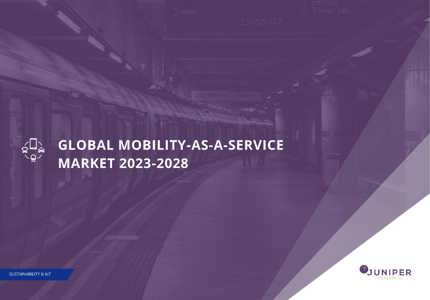Click It to Ride: How Mobility-as-a-Service is Revolutionising the Business of Public Transport
What is Mobility-as-a-Service?
Mobility-as-a-Service (MaaS) enables users to plan, book and pay for a variety of mobility services, through a joint digital channel. It is a shift away from personally owned modes of transportation services towards shared forms of mobility, provided as a service. This is achieved through various combinations of public transportation (eg trains and buses), private vehicles (eg ride-hailing services and taxi services), and micromobility (eg bikes and scooters) – with users able to pay for these services on a monthly subscription basis.
This model provides a significant opportunity for transport providers not only to change the way users travel, but to generate new revenue streams – a vital necessity following the disruption caused by the pandemic, and one which will grow in importance as consumers in major markets, such as the US and UK, grapple with growing inflation and increases in everyday essentials such as transport and fuel.
What Benefits Does the Subscription Model Offer?
At present, travellers, particularly commuters, frequently purchase season tickets for trains or buses, but these are line specific and do not integrate other modes of transportation. MaaS provides an opportunity to offer a multimodal subscription package, which would entail one monthly charge for unlimited use of transport services.
This approach has multiple benefits:
- Cost Efficiency: By using a MaaS subscription, users will be able to realise cost savings over their existing forms of travel. For the cost of an existing train season ticket, for instance, users will be able to access a multimodal system - a significant driver in itself.
- Incentives: As MaaS is intended to improve environmental sustainability, vendors can offer users incentives for changing their behaviours. This can include free miles or discounted subscriptions, which will further enhance the user experience.
- Simplicity: By offering access to services via a single payment, the user experience is greatly simplified. Users will not have to check what services they are using, and the allowances involved. This will be a great benefit, particularly for travellers with substantial travel usage such as commuters and business travellers.
What Are the Challenges of the Subscription Model?
The subscription model will, however, need to establish its value quickly, and users will need to take full advantage of the transport modes included in their packages to justify the significant price tag, compared to the costs associated with traditional public transport. MaaS vendors, therefore, have an educational task at hand to ensure potential users are aware of the long-term financial benefits. Partnerships are also crucial in enabling appealing customer offerings in terms of subscriptions. In particular, subsidies from public transport operators will be essential in enabling MaaS platforms to offer cost-effective solutions.
Another challenge with subscription models is how they reconcile public transport operator involvement and whether they can offer bundled prices. This will largely depend on what type of MaaS business model is being used. A private model, which aims to get public transport onboard will struggle, as there is little incentive for the transport operator to bulk discount tickets and no way for the MaaS operator to make a margin on these sales. For this reason, a public-led model is far more likely to work, as these will be driven by public transport operators willing to subsidise services.
This situation is also compounded by the all-inclusive nature of subscription services. In a system where consumers can take a practically unlimited number of multimodal journeys for a single price, how do platform providers reconcile how much of this charge, per user, is received by each transport operator? By and large, apportionment methods differ between providers, and, in future, it may be the case that providers may use favourable apportionment arrangements to attract public and private transportation operators to their platforms, especially in areas where competition between platforms is high.
What’s the Alternative?
Alternatively, MaaS vendors can offer usage-based pricing models that can be sold on a pay-as-you-go basis; referred to as ‘ad hoc’ throughout this research. While subscription services promise ease of use, it is both a commitment and a large financial outlay. This will not be suitable for all users. Therefore, the ad hoc model will be important for the future of MaaS services. Ad hoc usage can be a way into the MaaS ecosystem. Over time, ad hoc users will understand the benefits of the platforms and will move to subscription models. In order to facilitate this, MaaS platform providers must ensure that subscription models compare favourably in terms of pricing to ad hoc usage.
Juniper Research’s View
Both subscription and ad hoc models have an important role to play in the future of MaaS. In the short term, it is likely that the ad hoc model will be more suitable for users who are early adopters of MaaS. As MaaS is a new concept, trust has not been established in the user base. Before committing to a monthly subscription service, users will need to understand the benefit of choosing it and believe that the MaaS concept works. Therefore, the subscription model will grow in importance over time and, eventually, be a significant driver of MaaS among consumers. In order to further drive adoption, we also believe that vendors should maximise their flexibility to users by offering daily, weekly, and annual subscriptions, to better compete with existing season tickets.
Latest research, whitepapers & press releases
-
 ReportDecember 2025
ReportDecember 2025AI Agents for Customer Experience Platforms Market: 2025-2030
Our comprehensive AI Agents for Customer Experience Platforms research suite comprises detailed assessment of a market that is set to disrupt mobile communications. It provides stakeholders with insight into the key opportunities within the AI agents for customer experience platforms market over the next two years.
VIEW -
 ReportDecember 2025Fintech & Payments
ReportDecember 2025Fintech & PaymentseCommerce Fraud Prevention Market: 2025-2030
Our eCommerce Fraud Prevention research suite provides a detailed and insightful analysis of this evolving market; enabling stakeholders from financial institutions, law enforcement agencies, regulatory bodies and technology vendors to understand future growth, key trends, and the competitive environment.
VIEW -
 ReportNovember 2025Telecoms & Connectivity
ReportNovember 2025Telecoms & ConnectivityeSIMs & iSIMs Market: 2025-2030
Juniper Research’s eSIMs and iSIMs research suite offers insightful analysis of a market set to experience significant growth in the next five years. The research suite provides mobile network operators (MNOs), original equipment manufacturers (OEMs), and eSIM management and platforms vendors with intelligence on how to capitalise on the market growth, and guidance on how eSIM-only devices and sensors, SGP.42, in-factory provisioning, and iSIMs will change the competitive landscape.
VIEW -
 ReportNovember 2025Fintech & Payments
ReportNovember 2025Fintech & PaymentsModern Card Issuing Platforms Market: 2025-2030
Our Modern Card Issuing Platforms Market research suite provides a detailed and insightful analysis of this evolving market; enabling stakeholders from banks, financial institutions, fintech companies, and technology vendors to understand future growth, key trends, and the competitive environment.
VIEW -
 ReportNovember 2025Fintech & Payments
ReportNovember 2025Fintech & PaymentsDigital Wallets Market: 2025-2030
Our digital wallets research suite provides detailed analysis of this rapidly changing market; allowing digital wallet providers to gain an understanding of key payment trends and challenges, potential growth opportunities, and the competitive environment.
VIEW -
 ReportOctober 2025Fintech & Payments
ReportOctober 2025Fintech & PaymentsDigital Identity Market: 2025-2030
Juniper Research’s Digital Identity research suite provides a comprehensive and insightful analysis of this market; enabling stakeholders, including digital identity platform providers, digital identity verification providers, government agencies, banks, and many others, to understand future growth, key trends, and the competitive environment.
VIEW
-
 WhitepaperDecember 2025Telecoms & Connectivity
WhitepaperDecember 2025Telecoms & ConnectivityHuman + AI: Drivers of Customer Experience AI Agents in 2026
Our complimentary whitepaper, Human + AI: Drivers of Customer Experience AI Agents in 2026, examines the key drivers of the AI agents for customer experience platforms market in 2025.
VIEW -
 WhitepaperDecember 2025Fintech & Payments
WhitepaperDecember 2025Fintech & PaymentsBeyond Chargebacks: The True Cost of Fraud for Digital Commerce
Our complimentary whitepaper, Beyond Chargebacks: The True Cost of Fraud for Digital Commerce, examines the state of the eCommerce fraud prevention market; considering the impact of evolving digital fraud strategies, including key trends such as identity theft, account takeovers, chargebacks, policy abuse and friendly fraud.
VIEW -
 WhitepaperNovember 2025Telecoms & Connectivity
WhitepaperNovember 2025Telecoms & ConnectivityeSIM-only Devices: The Impact on Operators, Consumers, and IoT
Our complimentary whitepaper, eSIM-only Devices: The Impact on Operators, Consumers, and IoT, explores the challenges and opportunities for the three segments, with a particular focus on eSIM-only smartphones and SGP.42.
VIEW -
 WhitepaperNovember 2025Fintech & Payments
WhitepaperNovember 2025Fintech & PaymentsUnlocking the Next Stage of Growth for Modern Card Issuing Platforms
This free whitepaper analyses key trends shaping the modern card issuing space, and the ways in which modern card issuing platforms can capture growth.
VIEW -
 WhitepaperNovember 2025Fintech & Payments
WhitepaperNovember 2025Fintech & PaymentsTop 10 Fintech & Payments Trends 2026
Fintech is evolving fast. From stablecoins to agentic AI, our annual guide reveals the shifts redefining payments, digital identity, and the future of money in 2026. Download your copy today.
VIEW -
 WhitepaperNovember 2025Fintech & Payments
WhitepaperNovember 2025Fintech & PaymentsDigital Wallets: Empowering Financial Inclusivity
Our complimentary whitepaper, Digital Wallets: Empowering Financial Inclusivity, examines the state of the digital wallets market; considering the impact of digital wallets on different geographies, how they are shaping the modern payments landscape through lower transaction fees and promoting financial inclusivity for underbanked populations, and how they are competing with established payment methods.
VIEW
-
Telecoms & Connectivity
Travel eSIM Margins Under Pressure as Revenue per Gigabyte Falls 10% Globally in Two Years
December 2025 -
Telecoms & Connectivity
AI Agents to Power 1,000% More Customer Interactions for Enterprises Globally by 2027
December 2025 -
IoT & Emerging Technology
Global D2C Revenue Set for $370 Million Surge, But Satellite Operators Should Not Chase Full MNO Status
December 2025 -
Fintech & Payments
Digital Goods Fraud to Cost eCommerce Merchants $27 Billion Globally by 2030 as AI Tools Accelerate Attacks
December 2025 -
Fintech & Payments
AML Adoption to Hit 3.8 Million Businesses Globally by 2030, With Europe at the Forefront
November 2025 -
Telecoms & Connectivity
eSIM Connections to Grow 300% Globally in Next 5 Years, as China Presents Instant Opportunities
November 2025





















